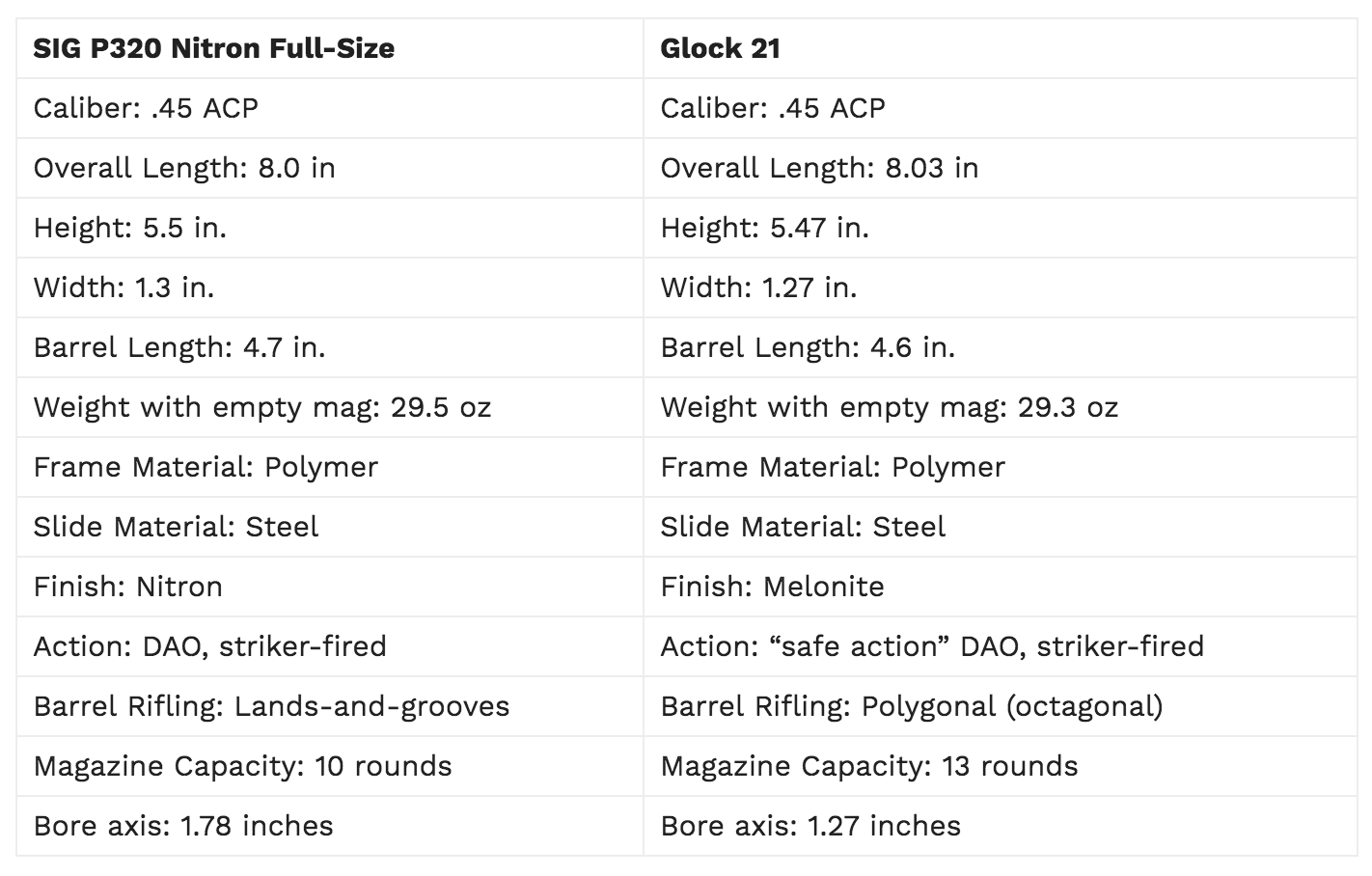What Would You Choose?: Sig Sauer's P320 Gun or Glock's 21?
Here's how they stack up.
Nothing’s worse than having to open a can of worms. We’ve all done it at least once in our lives and we never liked the outcome. Sometimes it’s just better to keep mum about certain touchy topics concerning politics, religion and sex, among others.
But here at Gun News Daily, we pride ourselves in tackling touchy gun-related issues the average Joe wouldn’t even dare try. That’s just who we are and what we do.
Over the past several months I have been comparing different types of handguns — mostly two different model Glock pistols at a time — to try and give our readers a different perspective, maybe help them decide which one to purchase if they’re new to the world of firearms.
While I did look at other pistols not manufactured by Glock — namely the two Cobra models (the FS 380 and the CA 380) and the two SIG Sauer models (the SIG P226 and the SIG P229) I compared in Rounds 5 and 6 of this series of our Handgun Showdowns respectively, I never compared two pistols from different manufacturers in this series.
Well, that all changes today.
Today, we’re comparing the SIG P320 in .45 acp and the Glock 21 Gen4, two pistols by two very different gun manufacturing companies that share the same solid reputation: their production firearms are as reliable as it gets.
THE TALE OF THE TAPE

So apart from the two pistols being manufactured by two companies well known for their products’ reliability, they share a few similar things. But let’s look at how each is different from one another so we can decide which is better for your use case scenario.Both the SIG P320 and the Glock 21 are robustly made, reliable, have good fit and finish and use polymer frames. Both also use a DAO (double action only) trigger mechanism.
DIMENSIONS AND WEIGHT
If you’ve been following this series of Handgun Showdowns you’d be familiar with how we normally compare handguns.
Full size handguns most of the time are great for home defense, competitive shooting and hunting (in the case of handguns chambered for 10mm at least).
But since they’re bigger, it’s automatically assumed that an ultra-compact, a sub-compact or even a compact handgun would beat them out when it comes to concealed carry.
Smaller guns are just inherently easier to carry concealed. That’s why we don’t bother talking too much about carrying a full size handgun concealed. There’s no point.
Not this time though. All SIG P320 pistols having a modular design means these can be great for almost everything — provided you’re willing to spend extra on the Caliber X-change kit, more on that below.
The full size SIG P320 chambered in .45 ACP can be had in a compact frame by changing the grip module. When converted, the SIG P320 will have a longer slide and barrel while having a shorter grip and shorter dust cover, giving it a bit of a railed 1911 look.
This compact version has an overall height of 5.3 inches which is two tenths of an inch shorter than the full size P320 and seventeen hundredths of an inch shorter than the Glock 21. The compact frame’s width measures the same as that of the full-size version though, which makes it three hundredths of an inch thicker than a Glock 21.
Converting the full size P320’s frame from a full size to a compact makes it easier to carry concealed as the shorter grip will not print as easily as full size grips.
Some Glock fans might cry foul when they see the comparison of dimensions above — they might say the comparison of compact pistols should be between the compact SIG P320 in .45 ACP and the Glock 30.
I might do that comparison in another article, but do keep in mind that this is an inherent advantage of the SIG P320 being a modular handgun platform. In this area, the SIG P320 in .45 ACP has a better value proposition than the Glock 21.
Back to comparing full size handguns, the full size SIG P320’s frame isn’t that much bigger than the Glock 21’s — it’s only about three hundredths of an inch wider and also three hundredths of an of an inch taller, so as far as width and height, both handguns measure about the same.
But the full size SIG P320’s overall length measures eight inches even, which is three hundredths of an inch shorter than the Glock 21’s overall length. Yet the former has a 4.7-inch barrel, a tenth of an inch longer than that of the latter.
BARREL
A shorter overall length that can accommodate a longer barrel is always a winner in my book — that said, SIG P320 barrels use a traditional lands-and-grooves type of rifling while all Glock barrels use a polygonal type of rifling (octagonal rifling in the case of Glock .45 ACP and .45 GAP barrels and hexagonal for all other smaller diameter barrels).
Glocks are known to push bullets faster because of their use of polygonal rifling, the only downside to it being Glock advises against shooting lead bullets in their barrels. If you’d like to know more about it, feel free to read this article where I talked about it greater depth.
SLIDE AND FRAME
Both handguns having a frame made of polymer means they weigh significantly lighter compared to other full-size handguns that use an all-steel or aluminum alloy frame.
Both also have steel slides, which is why both pistols are in the same weight category. That said, the SIG P320 full size is around a tenth of an ounce lighter than the Glock 21.
FINISH
The base model .45 ACP-chambered SIG P320 that we’re looking at today has a black finish SIG Sauer calls “Nitron”, while all Glock Gen4 pistols use “Melonite”.
These companies sure like to give fancy names to their guns’ finish. Having been brought up with 1911s and revolvers the only gun finishes I know are blued, parkerized, nickel-plated and stainless, so I decided to do a quick research on how Nitron and Melonite compare when it comes to corrosion resistance.
All SIG Sauer P320 pistols use a process called PVD (Physical Vapor deposition). The slides are bombarded with ions while in vacuum, which results in a protective coating applied to the metal surface by way of metal vapor. This gives the finish a rating of around 70 in the Rockwell C Hardness scale. In the case of Nitron, color is added to the PVD process to give P320 slides a black finish.
In contrast, Glock uses a ferritic-nitrocarburizing salt-bath process called Melonite(Glock enthusiasts argue that the company has always used Tenifer until 2011 when they first started using Melonite on Gen4 handguns — both Tenifer and Melonite are trademarked processes sold by the same company) to treat the slide’s surface.
Both Tenifer and Melonite are reported to have a rating of 64 in the Rockwell C Hardness scale. The coating on top of the treated slides is a little different compared to previous generation Glock pistols, which results in Gen4 having a lighter shade of gray finish compared to the somewhat blacker finish in previous Gen1 to Gen3 Glocks.
If all these online data on hardness are accurate, the SIG P320’s finish should be a bit more durable than that of the Glock 21.
THE SIG P320
In January 2014, the first SIG P320 pistols (chambered in 9x19mm Parabellum) became available in the US civilian and law enforcement market. At first glance these were just the same SIG P250s, the only differences being the early P250s used a DAO (double action only) hammer-fired mechanism and had a steel frame, while the newer P320 uses a DAO striker-fired mechanism and a polymer frame.
But what could be the P320’s most defining attribute which would three years later win it the US Military’s (MHS) Modular Handgun System contract by besting other polymer pistols of competing gun manufacturers is its modularity, akin to the AR platform.
In fact it’s what SIG designed these pistols for. Inside the P320’s frame is a trigger assembly housed in a stainless steel chassis called the FCU (Fire Control Unit). It has the trigger and all the linkages and springs necessary for the gun to fire.
This FCU trigger assembly group can be removed and installed to four different size frame (full size, compact, carry and subcompact) by the user and requires no knowledge of gunsmithing or tools. This is achievable via SIG Sauer’s Caliber X-change kit.
Talking about the trigger, SIG Sauer states in their website that the P320’s trigger reset is short, cleaner and crisper compared to their competitors’ handguns (they were obviously making a reference to Glock’s pistols being their closest rival, as people who own Glocks regularly talk about how mushy the Glock trigger feels).
And disassembly is also supposedly safer because the trigger does not have to be pulled, eliminating potential risks of accidental discharges (again they were obviously making a reference to how a Glock pistol’s trigger has to be pulled to field strip the gun).

